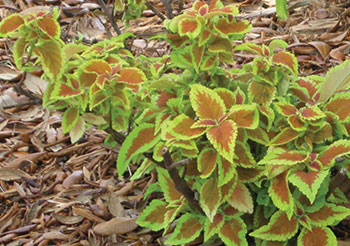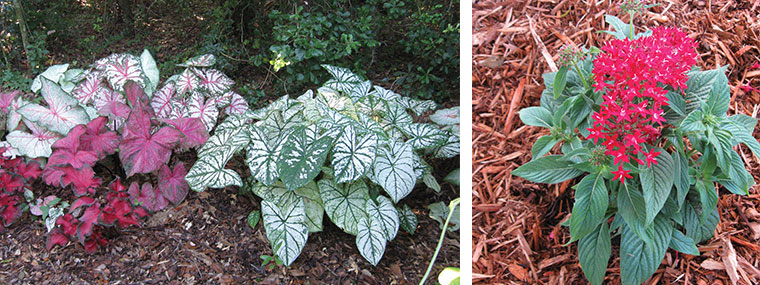
Heat-Seeking Annuals
by Lynn Barber / Published May 2015
Annuals provide a great opportunity to color-up your landscape, front porch, and lanai, whether in the ground or in containers. Most Florida annuals last one season, not one year. There are both warm and cool season annuals. This article focuses on warm season annuals, which are so named because they are damaged by frosts and freezes.
You need to know your site conditions because these elements will help you make plant selection decisions that will save you time and money. Consider whether the planting area is in the sun, shade, or part sun and part shade. Is the soil texture clay loam, sandy loam, sand, or sandy clay? Is the area well drained, wet, or in between? What is the size of the landscape bed you want to utilize? Once you have this information, you can make good plant selection decisions because if you purchase first and make these determinations later, the plants will not survive or thrive. That will cost you time and money to purchase replacements.
For plant selection, you may need to do a little homework on the plants you want; such as their mature size, whether they are warm season plants or cool season plants, need sun or shade, preferred soil type, etc. Just because plants are sold at a certain time of year does not mean they will thrive at that time of year in your landscape, which is why a little research on your part may be worth it dollar and time-wise. This is easier than it appears. Access the University of Florida website edis.ifas.ufl.edu, and you can type in specific plants and many other topics to review the information you seek.
Site preparation is also important. Add two to three inches of organic matter to the soil surface. This can be peat, compost (processed worm, mushroom, cow manure), or a potting soil mixture. Top the compost with a controlled-release fertilizer according to the label and mark your calendar when the next application will be needed.
 Dig the hole for the plant so 10 percent of the container size is above ground level. Water the plant before and after it is planted. Space the plants according to their mature size, not how they look the day you plant them. Water as needed until the plants are established, which means you can see shoot growth. (It also means root growth, but it’s hard to see that when roots are below the ground!) Microirrigation works well for watering annuals, and be sure to direct the water to the roots and soil, not to the leaves or flowers.
Dig the hole for the plant so 10 percent of the container size is above ground level. Water the plant before and after it is planted. Space the plants according to their mature size, not how they look the day you plant them. Water as needed until the plants are established, which means you can see shoot growth. (It also means root growth, but it’s hard to see that when roots are below the ground!) Microirrigation works well for watering annuals, and be sure to direct the water to the roots and soil, not to the leaves or flowers.
Mulch the area so it is two to three inches deep when settled and pull the mulch away from the base of the plants. Mulch retains soil moisture, and this could damage the plant and attract insects or disease. Mulch moderates the soil temperature, reduces runoff and erosion, improves the soil structure, suppresses weeds, and enhances the beauty of the landscape.
I selected five warm season annuals that do well in north, central, and south Florida. They include Caladium, Coleus, Pentas, Shrimp plant, and Wax begonia.
Caladium: This is a fast-growing bulb that can reach a height and spread of one to two feet. It prefers slightly acidic to slightly alkaline soil pH of 6.0–7.2. Any soil texture works well. Soil moisture should be well drained. Caladium has medium-drought tolerance and low-to-no salt tolerance. Different varieties prefers partial shade, full shade, or full sun.
Coleus: This is a fast-growing plant that can reach a height and spread of one to three feet. It prefers slightly acidic to slightly alkaline soil pH of 6.0–7.2. Any soil texture works well. Soil moisture should be medium drained. Coleus has a low-drought tolerance and low-to-no salt tolerance. It prefers full sun and performs well in partial shade/partial sun. Propagation from cuttings is very easy.
Pentas: This is another fast-growing annual that can reach a height of two to four feet and a spread of two to three feet. It prefers slightly acidic to slightly alkaline soil pH of 6.0–7.2. Any soil texture works well. Soil moisture should be well drained. Pentas has medium-drought tolerance and medium salt tolerance. It prefers full sun and performs well in partial shade/partial sun. This annual attracts butterflies and hummingbirds.
Lynn Barber, Agent
University of Florida/FAS Extension, Hillsborough
Lynn Barber, Agent, University of Florida/IFAS Exten-sion, Hillsborough County, is responsible for educating residents on the nine principles of the Florida Friendly LandscapingTM program. These principles include right plant right place, water efficiently, fertilize appropriately, mulch, attract wildlife, manage yard pests responsibly, recycle, reduce stormwater runoff, and protect the waterfront. Barber is past president of the Florida Association of Natural Resource Extension Professionals and has received numerous awards for programming, publications, and television and radio segments. As a Master Gardener, she has given back thousands of hours in environmental horticulture education to the community.
Shrimp plant: This is another fast-growing annual that can reach a height of two to six feet and a spread of two to four feet. It prefers acidic to slightly alkaline soil pH of 4.5–7.2. Any soil texture works well. Soil moisture should be wet. Shrimp plant has medium-drought tolerance and low-to-no salt tolerance. It prefers full sun and performs well in partial shade/partial sun. This annual attracts butterflies, birds, and hummingbirds. Propagation from cuttings is very easy.
Wax begonia: This is a slow-growing annual that can reach a height and spread of a half to one foot. It prefers slightly acidic to slightly alkaline soil pH of 6.0–7.2. Any soil texture works well. Soil moisture should be well drained. Wax begonia has low-drought tolerance and low-to-no salt tolerance. It prefers partial shade/partial sun.
For more information on annuals, please see the University of Florida publication, Gardening with Annuals, by Sydney Park Brown, at edis.ifas.ufl.edu/mg319, from which this article was adapted. The University of Florida has Gardening Calendars available online for three regions in the state. These calendars contain month-by-month information on what to plant, when to prune, fertilize, etc. To view the calendar for your area of the state, see edis.ifas.ufl.edu/ep451 for the North Florida Gardening Calendar, edis.ifas.ufl.edu/ep450 for Central Florida, and edis.ifas.ufl.edu/ep452 for South Florida.
As always, follow the landscape or architectural control procedures in your deed restrictions before making changes. For more information about the nine principles of the Florida-Friendly LandscapingTM Program or for assistance with gardening-related questions, contact your local Extension office and/or visit the University of Florida website solutionsforyourlife.com or edis.ifas.ufl.edu.



